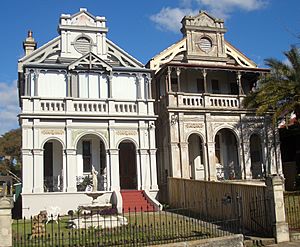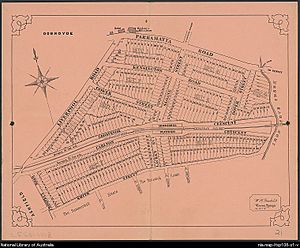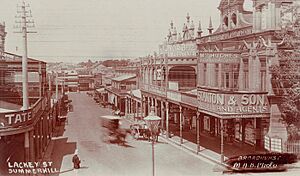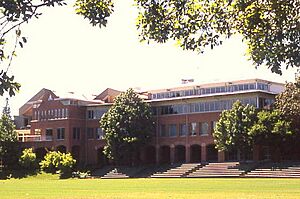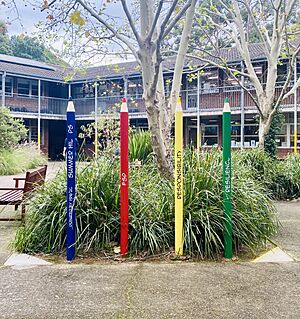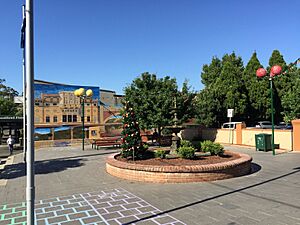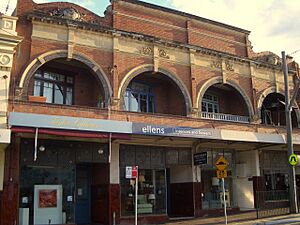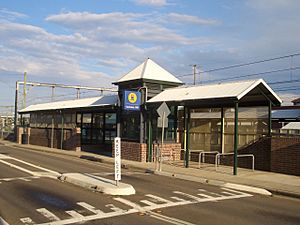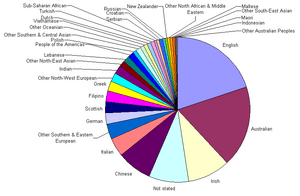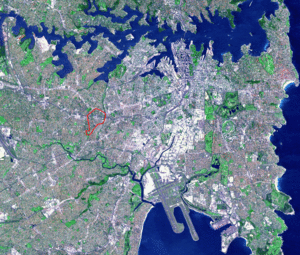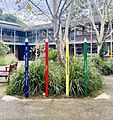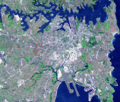Summer Hill, New South Wales facts for kids
Quick facts for kids Summer HillSydney, New South Wales |
|||||||||||||||
|---|---|---|---|---|---|---|---|---|---|---|---|---|---|---|---|
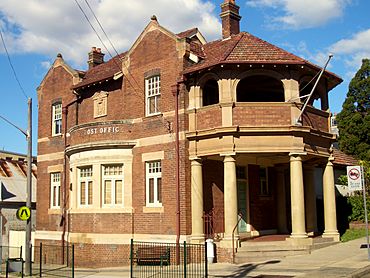
The former Summer Hill Post Office, Smith Street, is heritage-listed
|
|||||||||||||||
| Postcode(s) | 2130 | ||||||||||||||
| Elevation | 21 m (69 ft) | ||||||||||||||
| Area | 1.1 km2 (0.4 sq mi) | ||||||||||||||
| Location | 7 km (4 mi) west of Sydney CBD | ||||||||||||||
| LGA(s) | Inner West Council | ||||||||||||||
| State electorate(s) | Summer Hill | ||||||||||||||
| Federal Division(s) | Grayndler | ||||||||||||||
|
|||||||||||||||
Summer Hill is a suburb in Sydney, New South Wales, Australia. It is located about 7 kilometres west of Sydney's city centre. Summer Hill is part of the Inner West Council area.
This suburb is mostly a place where people live. It is close to two main roads in Sydney: Parramatta Road and Liverpool Road. The first land here was given out in 1794. This was to a former convict and jailer named Henry Kable. The area really started to grow when the train station opened in 1879.
In the 1920s, Summer Hill became a fancy area. Many large homes and mansions were built. Some of these old buildings are still here today. Later, in the mid-1900s, it became more of a working-class suburb. Many big estates were pulled down or divided into smaller blocks. Today, Summer Hill has a "village" feel. It has a mix of apartment buildings and older Federation-style houses.
Contents
What Makes Summer Hill Special?
Summer Hill is bordered by Parramatta Road and Liverpool Road to the north. Old Canterbury Road is to the south. The Inner West Light Rail line is to the east. Nearby suburbs include Haberfield (north), Lewisham (east), Dulwich Hill (south), and Ashfield (west).
The suburb has many Federation-era houses. There are also apartment blocks close to the train station. Most of the shops are run by local business owners. The local council wants to keep the suburb's "village" feel. Summer Hill has a rich history. More than 100 buildings are listed as heritage sites. This means they are important and protected. Residents care a lot about keeping the old buildings.
Summer Hill has changed over the years. It used to be a working-class area. Now, it has become more popular and expensive. This is called gentrification. Culturally, Summer Hill is a mix of different influences. There are European styles, with some Italian touches from nearby Leichhardt and Haberfield. There are also Asian influences, especially Chinese, from Ashfield to the west. Many other cultures also add to the mix.
A Look at Summer Hill's Past
First People of Summer Hill
Before Europeans arrived in 1788, the area now known as Summer Hill was home to Aboriginal people. The Wangal and Cadigal nations lived here. Experts believe that 8,000 to 10,000 Aboriginal people lived in the greater Sydney area. The Hawthorne Canal (once called Long Cove Creek) was likely the border between the Cadigal and Wangal lands. Today, there is a small park in Summer Hill called Cadigal Reserve. It is named after the Cadigal people. The nearby waterways were a good source of fish and shellfish for these coastal tribes.
In the early days of the colony, the land between Iron Cove and the Cooks River was called Kangaroo Ground. This suggests that kangaroos were common here. They were likely an important food source for the Aboriginal people.
European Settlers Arrive
The first land grant in this area was in 1794. It was given to Henry Kable, a former convict and jailer. The name "Summer Hill" was first used for a land division in 1876. This was near the St Andrew's Anglican Church. People think the name was chosen by the person who divided the land. They might have liked the name because it reminded them of England.
Summer Hill's biggest mansion was Carleton. It was built in the early 1880s on Liverpool Road. The suburb grew quickly when the train station opened in 1879. More land was then divided for housing. From 1880 to 1910, Summer Hill became a popular place for wealthy people. Many professionals who worked in the city chose to live here. In the 1920s and 1930s, more gardens were turned into housing. Some richer residents moved to the North Shore. In the 1970s, many of the remaining mansions were pulled down. This made way for apartment buildings, especially near the train station.
Important Heritage Sites
Summer Hill has some places that are protected for their history. These include:
- Grosvenor Crescent: Lewisham Sewage Aqueduct
Churches and Other Places of Worship
Summer Hill has several places where people can worship. St Patrick's Catholic Church was built in 1874. It is the oldest known building in the suburb. There is also a small primary school next to the church. The church building was originally a private home called Kelvin Grove. It was owned by Mrs Jane Drynan. The outside of the church still looks much like it did. The first church service was held here on St Patrick's Day in 1946. This is why it is called St Patrick's.
St Andrew's Anglican Church has three special arches inside. It was designed by Alexander Leckie Elphinstone Junior. Building started in 1883, and the spire was finished in 1906. It was built quickly, which showed how wealthy the area was back then.
Because of the many Asian cultures in Summer Hill, there are also non-Christian places of worship. The Wong Tai Sin (or Kwan Yin Kur) temple is on Kensington Road and Liverpool Road. This building used to be a Masonic temple in the 1920s. The ground floor of the temple is for the Taoist god Wong Tai Sin. The top floor is for the Buddhist Bodhisattva Kwan Yin.
Schools in Summer Hill
Trinity Grammar School is a private school for boys. It teaches students from Pre-Kindergarten to Year 12. This school site has been used for education for 120 years. The headmaster's house was built around 1877. The site was home to different schools before the Anglican Church bought it. It became Trinity Grammar School in 1925.
Summer Hill Public School is a primary school on Moonbie Street. It teaches students from Kindergarten to Year 6. It also has special classes for gifted Year 5 and 6 students. The school started in 1883 in a wooden shed. The older buildings you see today were built in 1913. Newer buildings were added in 1977, 1998, and 2010. The school's design is in the Victorian Classical style. It is listed on the Register of the National Estate, meaning it's an important historical site.
Saint Patrick's Catholic School is another private primary school. It is close to Summer Hill Public School.
Shopping and Local Businesses
Summer Hill's shopping area is around a small town square. It is easy for people to walk around. There are many cafés and restaurants on Lackey and Smith Streets. Summer Hill is a small suburb for Australia. It has just over 7,000 people and covers about 1.1 square kilometres. You can see beautiful buildings from the 1800s and early 1900s here.
The Summer Hill flour mill was built around 1922. It used the train line that carried goods. The tall silos were added from the 1950s. The flour mill was owned by different companies over the years. In 2007, it was sold to a developer. They have turned the mill site into homes and shops. This area now hosts a regular market for fresh food and handmade goods.
Getting Around Summer Hill
In 2016, most people in Summer Hill travelled to work by train (36%). Driving a car was the next most common way (32.9%). Some people walked (4%) or worked from home (3.8%). Summer Hill is near major roads like Liverpool Road and Parramatta Road. These roads can get very busy during rush hour.
From 1915, trams also served Summer Hill. They ran along Prospect Road, Smith Street, and Lackey Street. However, not many people used them, and buses became more popular. So, the tram line closed in 1933. You can still see some parts of the old tram line today.
Summer Hill railway station is on the Main Suburban railway line. The train station opened on September 15, 1879. Most of the local shops are very close to the station.
There are also two stations in Summer Hill for the Inner West Light Rail. These are Lewisham West (near the old flour mill) and Taverners Hill (near Parramatta Road). Taking the train is faster to get to the city. But the light rail is useful for travel to other nearby areas. It also connects with Dulwich Hill railway station.
Several bus routes serve Summer Hill. These include routes 480, 483, 461, and 413. There are also NightRide buses (N70, N71, N80) that run at night.
The area is also becoming more friendly for bicycles. There are several bike paths. A local group called "Friends of the Greenway" wants to build a path for bikes and walkers next to the light rail line.
Who Lives in Summer Hill?
Population Details
In the 2021 Census, Summer Hill had 7,288 people living there. The area is about 1.1 square kilometres. About 52.8% of the people were female, and 47.2% were male. Most people (64.1%) were born in Australia. Other common birthplaces included China (3.7%), England (3.5%), and New Zealand (1.9%).
Most people (69.8%) spoke only English at home. Other languages spoken included Mandarin (4.8%), Cantonese (1.9%), and Korean (1.7%). For religion, many people said they had no religion (52.8%). Others were Catholic (18.6%) or Anglican (5.7%). Most homes were flats, units, or apartments (63.1%). Some were separate houses (19.6%) or semi-detached/terrace houses (17.0%).
Famous People from Summer Hill
Many interesting people have lived in or were born in Summer Hill, including:
- Normand Henry Baker (1908–1955), a famous artist who won the Archibald Prize.
- Dr John Belisario (1820–1900), a dentist who was the first in Australia to use ether for dental work.
- Colonel Matron Kathleen Best (1910–1957), the first leader of the Women's Australian Army Corps.
- Virginia Gay, an actress from the TV show All Saints.
- Happy Hammond (1917–1998), a well-known radio and TV host.
- John Paton (1833–1914), who won the Victoria Cross for bravery. A park in Summer Hill is named after him.
- Arthur Streeton (1867–1943), a famous Australian artist.
- Ian Temby QC (born 1942), the first head of a special anti-corruption group in New South Wales.
- Rt Hon Sir Cyril Walsh (1909–1973), a lawyer and judge of the High Court of Australia.
Images for kids


